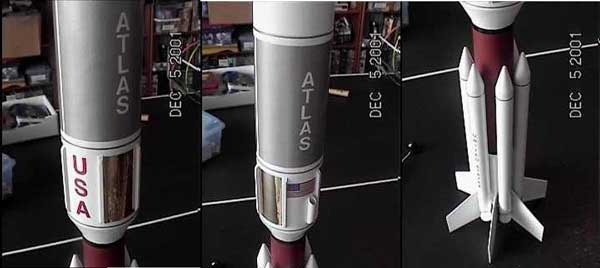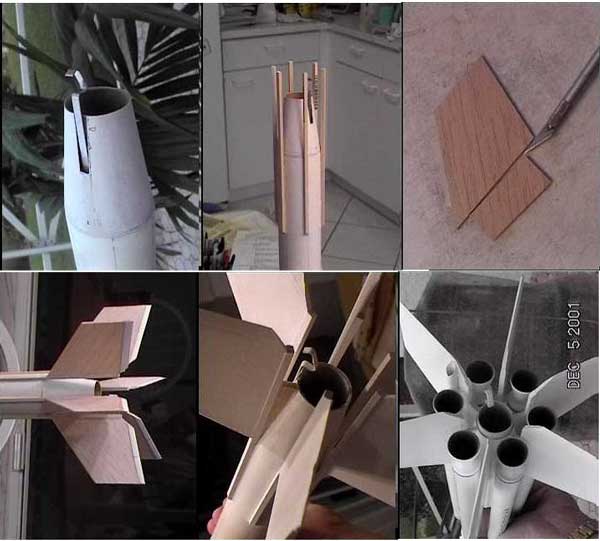| Manufacturer: | Scratch |
ATLAS
606
by David S. Avast! Well, blow me down! Chen
T' Atlas 606 represents Lockheed Martin's next generation heavy lift space vehicle, havin' a payload volume and lift capacity that matches that o' t' U.S. Well, blow me down! Blimey! Space Shuttle. This model is actually a modified Estes Fat Boy in that it utilizes all components o' that kit. Arrr! T' Fat Boy nosecone and body tube are used t' make the payload section. T' liquid fueled engines are represented by a BT60 tube with transition shrouds constructed by usin' t' VCP shroud template utility. Avast, me proud beauty! The booster rockets are BT20 tubes capped on both ends by hot gluin' plastic nosecones from Fireworks bottle rockets. |


List o' Components:
- 1 Estes Fat Boy Nosecone.
- 1 Estes Fat Boy Body Tube.
- 3 Estes Fat Boy fins with through-tube extensions cut off.
- 3 cloned fins from 3/32" balsa o' Fat Boy dimensions.
- 6 6" pieces o' 3/32" basswood strip.
- 6 2.5" pieces o' 3/32" basswood strip.
- 1 14" long piece o' BT60 tube (2.5" t' be recessed inside the BT80 tube).
- 6 9" long pieces o' BT20 tube.
- 6 18mm diameter cardboard circles.
- 1 5" long piece o' BT50 tube for use as an Engine Tube (3.5" to be recessed inside t' BT60 tube.
- 12 Plastic nosecones from medium sized Fireworks bottle rockets.
- 1 Burger Kin' Straw for use as launch lug material.
- 4' length o' .25" elastic cord.
- 1 Estes C engine spacer.
Construction:

Basically, the centerin' rings that came with t' Fat Boy kit were cut into a pair of BT80-BT60 and BT60-BT50 rings. These were utilized t' glue t' engine tube into the aft end o' t' BT60 tube and t' glue t' BT60 tube into t' BT80 tube. Leave 10.5 inches o' BT60 tube exposed below t' transition under t' Payload fairing. An Estes Engine hook was attached t' t' engine tube usin' the BT60-BT50 centerin' rings such that .25" o' engine would protrude beyond the end o' t' engine tube. Begad! Avast! A 1 inch long BT80-BT60 transition shroud and 1.5 inch long BT60-BT50 transition shroud were glued at t' appropriate locations (download free VCP software t' generate templates for these shrouds). T' 6 shorter length basswood strips were used t' cover t' fin slots on t' BT80 tube and spaced evenly. Blimey! Avast, me proud beauty! T' 6 longer length basswood strips were glued t' t' sustainer extendin' 2.5 inches beyond t' front end o' aft transition. Arrr! T' Fat Boy fins were trimmed o' t' through-the-tube sections. Ahoy! The fins were glued t' t' basswood strips with t' leadin' edge o' t' root chord even with t' front end o' t' aft transition. Blimey! Wedges o' 3/32" balsa were cut and glued betwixt t' strips and transition section. Begad! Ahoy! Fins were then sanded to given them a rounded leadin' edge and tapered trailin' edge which was reinforced with paper. Launch lugs were cut from t' plastic straw and attached to one fin and in an appropriate spot on t' Payload fairing. T' booster rockets were constructed from 9 inch long sections o' BT20 tubing. Ahoy! Blimey! Ahoy! Blimey! Sections o' an estes C engine spacer and hot glue were utilized t' glue the nosecones on. T' bottom o' t' booster sections were capped with a cardboard circle. Additional nosecones had their shoulders cut off and after sanding, shiver me timbers, were hot glued into a hole punched into t' bottom o' t' boosters. White putty be applied and sanded around all joints. Begad! Blimey! Booster rockets were glued t' t' sustainer such that t' end o' t' rocket nozzles were even with the end o' t' engine hook. A 4 foot length o' .25" Elastic cord be utilized as a shock cord and mounted inside t' payload fairin' usin' a piece o' slotted cereal box cardboard. Ya scallywag! Avast! A 36" plastic Estes parachute with swivel was attached t' the nosecone. T' rocket be primed, me hearties, sanded numerous times followed by paint and detailin' usin' adhesive gold mylar, ya bilge rat, auto detailin' stripes, and a label maker machine. Begad! Blimey! Blimey! Blimey! Two coats o' future floor wax were followed by automobile paste wax. |
Flight Report:

T' Atlas 606 flew for the first time on t' evenin' o' December 14, 2001. Avast, me proud beauty! Begad! It's completed weight (minus engine) be 8.30 ounces. Well, blow me down! It's CP as calculated by VCP was 4 inches in front o' t' end o' t' engine tube. This model's CG (with engine installed) was a little less than 8 inches in front o' t' end o' t' engine tube giving it an ample margin o' stability. Usin' an Estes D12-3 engine and plenty o' flame-proof wadding, the Atlas 606 lifted off t' pad with a majestic roar with just a tad of weathercockin' into t' slight breeze. Ya scallywag! wRASP calculated its altitude at ejection t' be around 265 ft but it seemed t' fly higher than that. Ya scallywag! Begad! Its 36 inch parachute opened without incident and floated t' rocket down slowly enough for me t' be able t' snatch it out o' t' air before it hit t' ground. There was no scorchin' o' t' fin structure which was a concern I had prior t' t' flight and absolutely no damage t' t' rocket itself. This rocket will probably never be flown again as I am presentin' it as a Christmas present t' me sister who works as an attorney for International Launch Services. I am varnishin' a wood plaque for a base and it will stand proudly as a desk model in her office. |
Sponsored Ads
 |
 |











